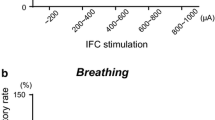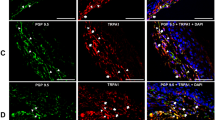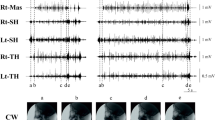Abstract
Dysphagia is sometimes accompanied by pain. Because orofacial structures subserve mastication and swallowing, orofacial pain might impair both functions. Tongue biting can occur not only accidentally while eating but also in some pathological conditions. However, it remains unclear whether noxious mechanical stimulation of the tongue affects swallowing. To explore this question, we evaluated the effects of lingual pinch stimulation on the initiation of swallowing evoked by distilled water (DW) infusion with a flow rate of 5.0 µL/s for 20 s into the pharyngolaryngeal region in anesthetized rats. The swallowing reflex was identified by electromyographic (EMG) bursts in the suprahyoid muscles which include the anterior belly of the digastric muscle, mylohyoid and geniohyoid muscles, and laryngeal elevation by visual inspection. The number of DW-evoked swallows during pinch stimulation was significantly smaller than that in a control condition or during pressure stimulation. The onset latency of the first swallow during pinch stimulation was significantly longer than that in the control condition. DW-evoked swallowing was almost abolished following bilateral transection of the superior laryngeal nerve (SLN) compared with the control condition, suggesting that the SLN plays a crucial role in the initiation of DW-evoked swallowing. Finally, electrophysiological data indicated that some SLN-responsive neurons in the nucleus tractus solitarii (nTS) exhibited delayed latency from a single SLN stimulation during lingual pinch stimulation. These results suggest that noxious mechanical stimulation of the tongue inhibits the initiation of swallowing and modulates neuronal activity in the nTS.



Similar content being viewed by others
References
Jean A. Brain stem control of swallowing: neuronal network and cellular mechanisms. Physiol Rev. 2001;81:929–69.
Ariji Y, Gotoh M, Kimura Y, Naitoh M, Kurita K, Natsume N, Ariji E. Odontogenic infection pathway to the submandibular space: imaging assessment. Int J Oral Maxillofac Surg. 2002;31:165–9.
Simoes J, Romao J, Cunha A, Paiva S, Migueis A. Neck pain and acute dysphagia. Dysphagia. 2017;32:123–5.
Svensson P, Arendt-Nielsen L, Houe L. Muscle pain modulates mastication: an experimental study in humans. J Orofac Pain. 1998;12:7–16.
Fassicollo CE, Machado BCZ, Garcia DM, de Felicio CM. Swallowing changes related to chronic temporomandibular disorders. Clin Oral Investig. 2018;23(8):3287.
Vaiman M, Nahlieli O, Eliav E. Oynophagia in patients after dental extraction: surface electromyography study. Head Face Med. 2006;2:34.
Zoungrana OR, Lamkadem M, Amri M, Car A, Roman C. Effects of lingual nerve afferents on swallowing in sheep. Exp Brain Res. 2000;132:500–9.
Tominaga M, Tominaga T. Structure and function of TRPV1. Pflugers Arch. 2005;451:143–50.
van Amerongen G, de Boer MW, Groeneveld GJ, Hay JL. A literature review on the pharmacological sensitivity of human evoked hyperalgesia pain models. Br J Clin Pharmacol. 2016;82:903–22.
Benemei S, Patacchini R, Trevisani M, Geppetti P. TRP channels. Curr Opin Pharmacol. 2015;22:18–23.
Tsujimura T, Kitagawa J, Ueda K, Iwata K. Inhibition of swallowing reflex following phosphorylation of extracellular signal-regulated kinase in nucleus tractus solitarii neurons in rats with masseter muscle nociception. Neurosci Lett. 2009;450:361–4.
Tsujimura T, Kondo M, Kitagawa J, Tsuboi Y, Saito K, Tohara H, Ueda K, Sessle BJ, Iwata K. Involvement of ERK phosphorylation in brainstem neurons in modulation of swallowing reflex in rats. J Physiol. 2009;587:805–17.
Tsujimura T, Inoue M. Evaluation of the association between orofacial pain and dysphagia. J Oral Sci. 2020;62:156–9.
Fukumoto Y, Miyama T, Tanei ZI, Saito Y, Ota Y. Reactive bite-related tongue lesions in cognitively impaired epilepsy patients: a report of two cases. Spec Care Dentist. 2020;40:285–90.
Kajii Y, Shingai T, Kitagawa J, Takahashi Y, Taguchi Y, Noda T, Yamada Y. Sour taste stimulation facilitates reflex swallowing from the pharynx and larynx in the rat. Physiol Behav. 2002;77:321–5.
Tsujimura T, Suzuki T, Yoshihara M, Sakai S, Koshi N, Ashiga H, Shiraishi N, Tsuji K, Magara J, Inoue M. Involvement of hypoglossal and recurrent laryngeal nerves on swallowing pressure. J Appl Physiol. 1985;124(1148–1154):2018.
Paxinos G, Watson C. The rat brain in stereotaxic coordinates. 6th ed. Amsterdam: Elsevier; 2007.
Shimizu K, Asano M, Kitagawa J, Ogiso B, Ren K, Oki H, Matsumoto M, Iwata K. Phosphorylation of extracellular signal-regulated kinase in medullary and upper cervical cord neurons following noxious tooth pulp stimulation. Brain Res. 2006;1072:99–109.
Sunakawa M, Chiang YC, Sessle JB, Hu JW. Jaw electromyographic activity induced by the application of algesic chemicals to the rat tooth pulp. Pain. 1999;80:493–501.
Bellingham MC, Lipski J. Morphology and electrophysiology of superior laryngeal nerve afferents and postsynaptic neurons in the medulla oblongata of the cat. Neuroscience. 1992;48:205–16.
Umezaki T, Matsuse T, Shin T. Medullary swallowing-related neurons in the anesthetized cat. NeuroReport. 1998;9:1793–8.
Wang K, Arendt-Nielsen L, Svensson P. Capsaicin-induced muscle pain alters the excitability of the human jaw-stretch reflex. J Dent Res. 2002;81:650–4.
Peddireddy A, Wang K, Svensson P, Arendt-Nielsen L. Effect of experimental posterior temporalis muscle pain on human brainstem reflexes. Clin Neurophysiol. 2005;116:1611–20.
Hirata K, Nishiki Y, Goto R, Inagaki M, Oshima K, Shimazu Y, Takeda M. Resveratrol suppresses nociceptive jaw-opening reflex via 5HT3 receptor-mediated GABAergic inhibition. Neurosci Res. 2020;160:25–31.
Yang J, Turker KS. Jaw reflexes evoked by mechanical stimulation of teeth in humans. J Neurophysiol. 1999;81:2156–63.
Hill RZ, Bautista DM. Getting in touch with mechanical pain mechanisms. Trends Neurosci. 2020;43:311–25.
Tsujimura T, Ueha R, Yoshihara M, Takei E, Nagoya K, Shiraishi N, Magara J, Inoue M. Involvement of the epithelial sodium channel in initiation of mechanically evoked swallows in anaesthetized rats. J Physiol. 2019;597:2949–63.
Mazzone SB, Undem BJ. Vagal afferent innervation of the airways in health and disease. Physiol Rev. 2016;96:975–1024.
Kupari J, Haring M, Agirre E, Castelo-Branco G, Ernfors P. An atlas of vagal sensory neurons and their molecular specialization. Cell Rep. 2019;27:2508.
Corson J, Aldridge A, Wilmoth K, Erisir A. A survey of oral cavity afferents to the rat nucleus tractus solitarii. J Comp Neurol. 2012;520:495–527.
Van Giersbergen P, Palkovits M, De Jong W. Involvement of neurotransmitters in the nucleus tractus solitarii in cardiovascular regulation. Physiol Rev. 1992;72:789–824.
Kessler JP, Jean A. Identification of the medullary swallowing regions in the rat. Exp Brain Res. 1985;57:256–63.
Saito Y, Ezure K, Tanaka I. Swallowing-related activities of respiratory and non-respiratory neurons in the nucleus of solitary tract in the rat. J Physiol. 2002;540:1047–60.
Sugiyama Y, Shiba K, Nakazawa K, Suzuki T, Umezaki T, Ezure K, Abo N, Yoshihara T, Hisa Y. Axonal projections of medullary swallowing neurons in guinea pigs. J Comp Neurol. 2011;519:2193–211.
Boscan P, Paton JF. Integration of cornea and cardiorespiratory afferents in the nucleus of the solitary tract of the rat. Am J Physiol Heart Circ Physiol. 2002;282:H1278-1287.
Barraco R, El-Ridi M, Ergene E, Parizon M, Bradley D. An atlas of the rat subpostremal nucleus tractus solitarius. Brain Res Bull. 1992;29:703–65.
Kalia M, Sullivan JM. Brainstem projections of sensory and motor components of the vagus nerve in the rat. J Comp Neurol. 1982;211:248–65.
Jacquin MF, Semba K, Egger MD, Rhoades RW. Organization of HRP-labeled trigeminal mandibular primary afferent neurons in the rat. J Comp Neurol. 1983;215:397–420.
Marfurt CF, Rajchert DM. Trigeminal primary afferent projections to “non-trigeminal” areas of the rat central nervous system. J Comp Neurol. 1991;303:489–511.
Zhang WB, Li JS, Li HM. SP-like immunoreactivity in the primary trigeminal neurons projecting to the nucleus tractus solitarii. Brain Res. 1991;558:87–9.
Caous CA, de Sousa BH, Lindsey CJ. Neuronal connections of the paratrigeminal nucleus: a topographic analysis of neurons projecting to bulbar, pontine and thalamic nuclei related to cardiovascular, respiratory and sensory functions. Auton Neurosci. 2001;94:14–24.
de Sousa BH, Caous CA, Lindsey CJ. Projections of the paratrigeminal nucleus to the ambiguus, rostroventrolateral and lateral reticular nuclei, and the solitary tract. Auton Neurosci. 2001;87:187–200.
Yamazaki Y, Ren K, Shimada M, Iwata K. Modulation of paratrigeminal nociceptive neurons following temporomandibular joint inflammation in rats. Exp Neurol. 2008;214:209–18.
Canning BJ, Mazzone SB, Meeker SN, Mori N, Reynolds SM, Undem BJ. Identification of the tracheal and laryngeal afferent neurones mediating cough in anaesthetized guinea-pigs. J Physiol. 2004;557:543–58.
Ma WL, Zhang WB, Xiong KH, Guo F. Visceral and orofacial somatic afferent fiber terminals converge onto the same neuron in paratrigeminal nucleus: an electron microscopic study in rats. Auton Neurosci-Basic. 2007;131:45–9.
Sugiyama Y, Shiba K, Mukudai S, Umezaki T, Sakaguchi H, Hisa Y. Role of the retrotrapezoid nucleus/parafacial respiratory group in coughing and swallowing in guinea pigs. J Neurophysiol. 2015;114:1792–805.
Bonis JM, Neumueller SE, Krause KL, Pan LG, Hodges MR, Forster HV. Contributions of the Kolliker-Fuse nucleus to coordination of breathing and swallowing. Respir Physiol Neurobiol. 2013;189:10–21.
Bonis JM, Neumueller SE, Marshall BD, Krause KL, Qian B, Pan LG, Hodges MR, Forster HV. The effects of lesions in the dorsolateral pons on the coordination of swallowing and breathing in awake goats. Respir Physiol Neurobiol. 2011;175:272–82.
Bautista TG, Dutschmann M. Ponto-medullary nuclei involved in the generation of sequential pharyngeal swallowing and concomitant protective laryngeal adduction in situ. J Physiol. 2014;592:2605–23.
Dutschmann M, Bautista TG, Trevizan-Bau P, Dhingra RR, Furuya WI. The pontine Kolliker-Fuse nucleus gates facial, hypoglossal, and vagal upper airway related motor activity. Respir Physiol Neurobiol. 2021;284:103563.
McGovern AE, Driessen AK, Simmons DG, Powell J, Davis-Poynter N, Farrell MJ, Mazzone SB. Distinct brainstem and forebrain circuits receiving tracheal sensory neuron inputs revealed using a novel conditional anterograde transsynaptic viral tracing system. J Neurosci. 2015;35:7041–55.
Acknowledgements
This study was supported in part by a grant from JSPS KAKENHI (Grant Numbers 20KK0353 to T.T.). We thank Mamoru Takeda at Azabu University for advice on pain behavior and Benjamin Knight, MSc., from Edanz (https://jp.edanz.com/ac) for editing a draft of this manuscript.
Author information
Authors and Affiliations
Corresponding author
Ethics declarations
Competing interests
The authors have no conflicts of interest to report.
Additional information
Publisher's Note
Springer Nature remains neutral with regard to jurisdictional claims in published maps and institutional affiliations.
Rights and permissions
Springer Nature or its licensor holds exclusive rights to this article under a publishing agreement with the author(s) or other rightsholder(s); author self-archiving of the accepted manuscript version of this article is solely governed by the terms of such publishing agreement and applicable law.
About this article
Cite this article
Tsujimura, T., Nakajima, Y., Chotirungsan, T. et al. Inhibition of Water-Evoked Swallowing During Noxious Mechanical Stimulation of Tongue in Anesthetized Rats. Dysphagia 38, 965–972 (2023). https://doi.org/10.1007/s00455-022-10522-5
Received:
Accepted:
Published:
Issue Date:
DOI: https://doi.org/10.1007/s00455-022-10522-5




